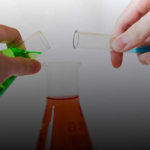Section 1
Preview this deck
molar mass
Front
Active users
0
All-time users
0
Favorites
0
Last updated
6 years ago
Date created
Mar 1, 2020
Cards (78)
Section 1
(50 cards)
molar mass
To find this, add masses of all elements in a compound together.
least
If pressure is increased to a gaseous reaction at equilibrium, the reaction will shift toward the side with the _________ amount of moles.
compressible
Gases are easily ____________ & expand to fill their container.
unsaturated
A(n) ____________ solution can hold more solute.
increased
Increased temperature = ___________ solubility for solids
pressure
In a gas, this is caused by the force of gas particles colliding with their container walls.
neutrons
neutral charge, found in nucleus
protons
positive charge, found in nucleus
isotope
Same element, different number of neutrons
cross method
This is how you identify the number of ions that will participate in an ionic bond.
mass number
________________ = protons + neutrons
H+
[____] = 1 x 10^-ph
22.4
There are ________ L of gas in 1 mol at STP
equilibrium
At _____________, the rates of the forward and reverse reactions are equal.
ionic
Metal + non-metal = _________ bond
atomic number
Identifies element; number of protons; how the periodic table is organized
electrons
negative charge, around the outside of the nucleus
10
How many electrons will fit in a d subshell?
products
If a reactant is added to a reaction at equilibrium, the reaction will shift toward __________.
strong acid
An acid that completely dissociates in solution
supersaturated
A(n) ____________ solution has more solute than it can hold. This is achieved with heat or stirring.
polar
In a __________ molecule, electrons are not shared evenly (a result of an uneven arrangement of electronegative atoms)
concentration
(M) How much solute vs. solvent there is
net charge
________________ = protons - electrons
4
Total # electrons shared in a double bond
products
If Keq > 1, then _________ are favored.
ionic
What is the strongest bond?
mol/L
M = ?
acid
Sour taste, turns litmus paper red, makes H+ in solutions
reactants
If Keq < 1, then __________ are favored.
base
Taste bitter, slippery, turn litmus paper blue, makes OH- in solutions
mole
6.02 x 10^23 particles of anything
shared
A pair of electrons are ________ for each covalent bond
pH
_____ = -log[H+]
2
How many electrons will fit in an s subshell?
solvent
What does the dissolving
solute
What is dissolved
14
How many electrons will fit in a f subshell?
ion
Same element, different number of electrons
6
How many electrons will fit in a p subshell?
salt
Ionic bonds form this type of compound
decreased
Increased temperature = ___________ solubility for gases
ionic
Which bond has the highest boiling point?
6
Total # electrons shared in a triple bond
8
Most main-group atoms will bond until they have __ electrons in their outer energy level
decimal
Sig Fig rules: Trailing zeros count only if a _______ is present.
covalent
non-metal + non-metal = _________ bond
14
pH + pOH = ?
solute
If the concentration is high, there is a lot of ___________ in a solution.
saturated
A(n) ____________ solution holds as much solute as possible.
Section 2
(28 cards)


